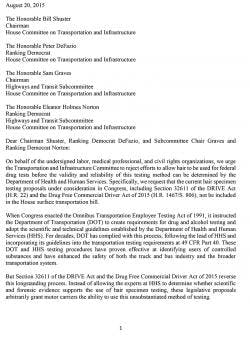Opponents: Cut short efforts to use hair for drug tests
A diverse group of organizations, including the ACLU, Teamsters and United Steelworkers, have written a letter to members of the House Committee on Transportation and Infrastructure opposing the inclusion of hair testing in any surface transportation bill.
In the letter, the group of 17 note that Congress is obligated, under the Omnibus Transportation Employee Testing Act of 1991, to require the Dept. of Transportation to follow drug and alcohol testing protocols adopted by the Dept. of Health and Human Services (HHS).
“For decades, DOT has complied with this process, following the lead of HHS and incorporating its guidelines into the transportation testing requirements at 49 CFR Part 40. These DOT and HHS testing procedures have proven effective at identifying users of controlled substances and have enhanced the safety of both the truck and bus industry and the broader transportation system,” the letter states.
The letter, authored by the Transportation Trades Department, AFL-CIO (TTD), was sent to Bill Shuster, chairman; Peter DeFazio, ranking democrat; Sam Graves, chairman of the Highways and Transit Subcommittee; and Eleanor Holmes Norton, ranking democrat on the Highways and Transit Subcommittee.
The Senate’s version of a highway bill, which was not passed as Congress, included a provision that would allow hair testing for pre-employment and random screening for commercial drivers.
“The Senate has undermined the expertise of scientists and potentially jeopardized the jobs of thousands of bus and truck drivers with this unproven testing method,” said TTD President Edward Wytkind. “We urge the House to reject the Senate’s hair testing provision and ensure that federal drug tests are backed by scientific and forensically sound evidence. Nothing less should be acceptable.”
According to the group, HHS has not made a final determination on whether hair testing is a valid approach to drug and alcohol screening.
Why hair testing makes for a safer industry
According to David Heller, director of safety and policy for the Truckload Carriers Assn. (TCA), hair testing is a viable and more effective solution for carriers. Writing in his monthly Safety 411 column in Fleet Owner magazine (May 2015), Heller wrote:
“For years, urine-based drug testing has been the only standard for drug testing. And it will continue to be that standard until the regulations change and allow for more than just urine to justify a carrier’s federal drug-testing obligations. However, carriers, and now our congressional leaders, not to mention FMCSA, are recognizing that hair testing has a place in the transportation industry. Many carriers are putting this procedure in place for their pre-employment and random testing protocols because the test shows a lengthier history of drug use rather than just recent use. This fact alone makes hair testing for drugs a better test for new hires. It allows motor carriers an opportunity to foresee what kind of drivers they are hiring.”
Heller went on to add that testing a 1.5 in. piece of hair provides a 90-day history of drugs in a person’s system.
“It should come as no surprise that TCA supports hair testing for illegal drugs with its policy on Alternative Specimens,” he wrote. “Our membership, much like its arguments against CSA, insists on always having the most accurate picture when it comes to telling a story. After all, if our industry holds true to its zero tolerance message, especially for those operating a commercial motor vehicle, we must also support and allow for a test that can be used to properly ascertain substance abuse among prospective drivers.”
Not all agree, though. In fact, TTD and others claim that hair testing has an inherent racial bias. In an April 10 article on Fleetowner.com, titled “Hair testing may be biased, ineffective,” Dr. Kent Peterson laid out the reasoning.
What hair testing has a racial bias
“Someone with white hair is not depositing any pigments in their hair shaft. I can use any drug I want and I will never test positive for drug use,” said Peterson, who is president of Charlottesville, VA-based Occupational Health Strategies and former executive vice president of American College of Preventive Medicine (ACPM), past president of American College of Occupational and Environmental Medicine (ACOEM), and co-founder and board member of Medical Review Officer Certification Council. “Curly haired and persons of color are more likely to test positive [because they have more melanin in their hair which binds more strongly with markers]. It’s believed that if hair testing were to be used and brought to court, it would be thrown out on that basis alone.”
In that same article, Lewis Maltby, president of the National Workrights Institute in Princeton, NJ, said it is Congress and drug testing facilities that want hair testing, not companies.
“The drug laboratories that do hair testing have been trying to be included in the federal testing program for 20 years and the scientists at NIDA [National Institute on Drug Abuse, part of the National Institutes of Health] say ‘no’ because they know that hair testing doesn’t work,” he said. “You can find a list of articles about how hair testing works but they’re written by people connected to the hair testing companies, and none have appeared in peer-reviewed journals. The only people who say hair testing works are those selling hair testing services.”

